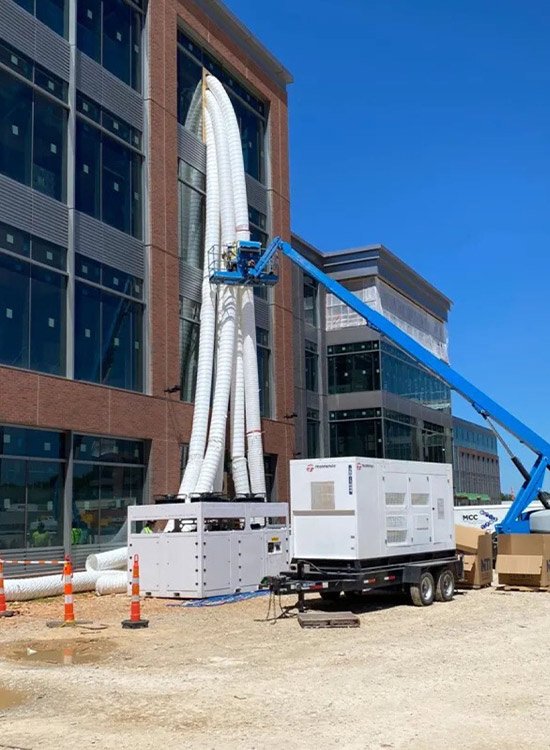How Flexible Insulated Ducts Reduce Energy Loss and Improve HVAC Performance
On a remote northern job site in the dead of winter or peak of the summer, keeping the worksite at an optimal temperature isn’t just about comfort; it’s about safety, productivity, and staying on schedule. We’ve seen it time and time again: climate control units roaring at full blast, yet half the air never makes it to the work zone. Why? Poor ducting. Rigid metal ducts that leak, crack, or simply aren’t built to handle the demands of industrial environments.
That’s where we come in.
As a heater rental company serving some of the toughest projects across Alberta, Western Canada, we’ve learned that flexible insulated ducts make all the difference. They’re built to handle harsh conditions, minimize heat loss over long distances, and deliver reliable performance even when temperatures drop to extreme lows. In this post, we’ll discuss how flexible insulated ducts reduce energy waste and improve HVAC performance, so your heat goes where it’s needed most.

Understanding Energy Loss in HVAC Systems
Ductwork is the highway through which air travels, and its efficiency can make or break your HVAC system’s performance, especially on complex or large-scale industrial projects. Energy loss in HVAC systems can occur in several ways. Some of the most common culprits include:
- Air leaks along duct seams or connections
- Poor insulation allows heat to transfer into or out of the ducts
- Inefficient or outdated materials that can’t maintain air temperature effectively
When heated or cooled air escapes or is altered during its journey, the system must work harder to maintain and deliver the desired temperature. This increases energy consumption and utility costs and reduces the system’s overall effectiveness.
Additional HVAC inefficiencies, such as unsealed joints, deteriorating ducts, and poorly routed layouts, only compound the problem. These issues lead to uncomfortable indoor conditions and put excessive wear on your HVAC units.
What Are Flexible Insulated Ducts?
Flexible insulated ducts are engineered to tackle these very problems. They’re made of three distinct parts:
- The inner core carries the air. Typically made of durable plastic or metal foil.
- The insulation layer reduces heat transfer. Often composed of fibreglass.
- The outer jacket protects the insulation and maintains the structure.
Traditional rigid metal ductwork is difficult and costly to install in tight or unconventional areas. That material can’t compare to modern, flexible ducts, which are lightweight, bendable, and easier to install without compromising airflow.
How Flexible Insulated Ducts Reduce Energy Loss
Flexible insulated ducts minimize energy loss and boost HVAC efficiency, making them the ideal choice for various industrial projects.
Superior Insulation: The thick, multi-layer insulation in flexible ducts helps preserve the temperature of the air as it travels, significantly reducing energy loss from heat transfer.
Reduced Air Leakage: Thanks to their sealed, continuous design, flexible ducts reduce the number of joints and seams, common areas where air typically leaks in rigid systems.
Moisture Management: Flexible ducts are less prone to condensation issues, and their materials resist moisture buildup. This helps prevent mould growth and maintains air quality.
Improving HVAC Performance with Flexible Insulated Ducts
Better insulation and reduced leakage result in more consistent airflow, ensuring every part of the building or covered area gets the heating or cooling it needs. Flexible ducts shine in installations with unusual layouts, easily snaking through walls, around beams, and into tight corners.
By reducing air resistance and ensuring proper airflow, these ducts reduce strain on HVAC units, which means longer system life, fewer repairs, and improved performance.
The Cost and Environmental Benefits of Flexible Ducts
Upgrading to flexible insulated ducts isn’t just good for performance; it’s also good for your bottom line. The efficiency of flexible air ducts reduces heat loss, resulting in less energy use and lower bills. Greater efficiency also means your project uses fewer units and has a smaller carbon footprint. Consuming less energy reduces greenhouse gas emissions, contributing to your project’s sustainability goals.
Flexible Insulated Ducts and Climate Control Solutions
Flexible insulated ducts are a smart, efficient solution for reducing energy loss and improving HVAC system performance, particularly for industrial and commercial environments. Their adaptability, innovative design, and easy installation make them a top choice for industrial climate control strategies.
Ready to improve your HVAC system’s efficiency and reduce costs? Contact our team today to learn more about our flexible insulated duct solutions and equipment rentals.
